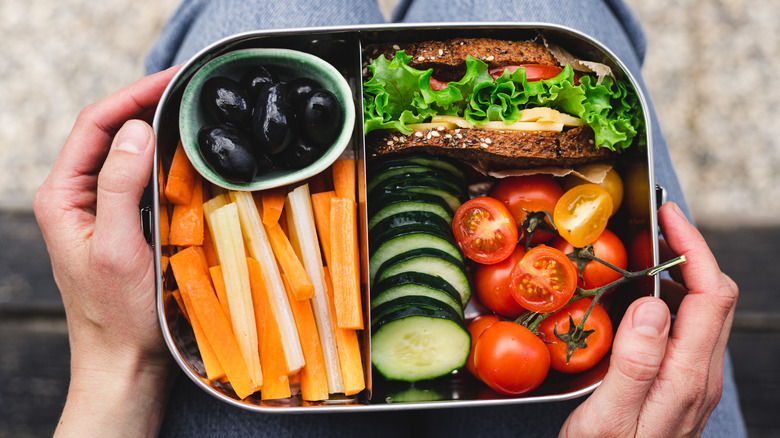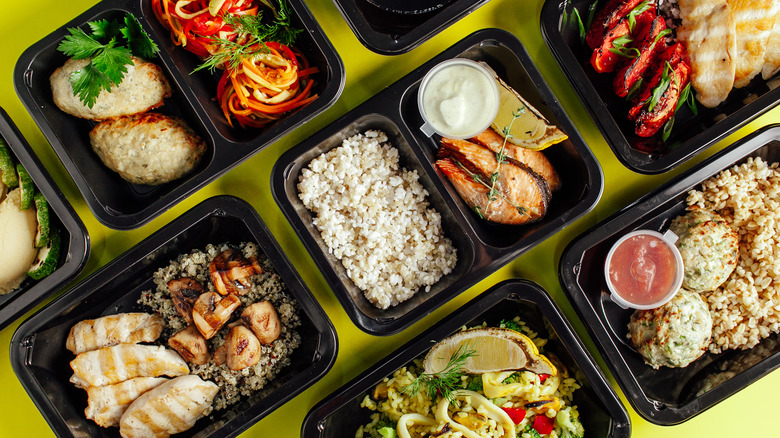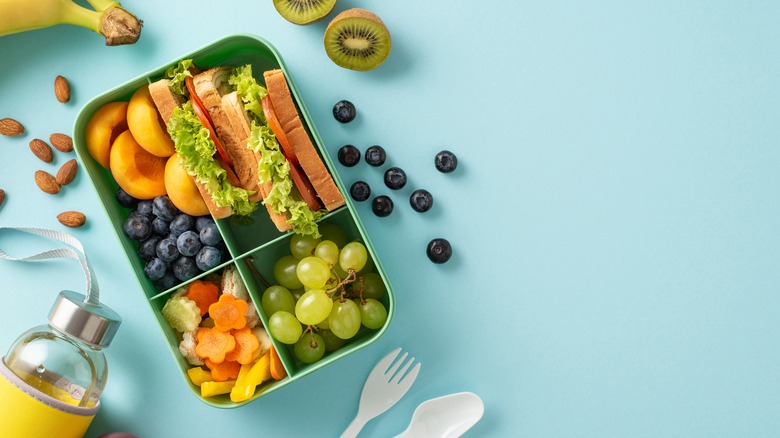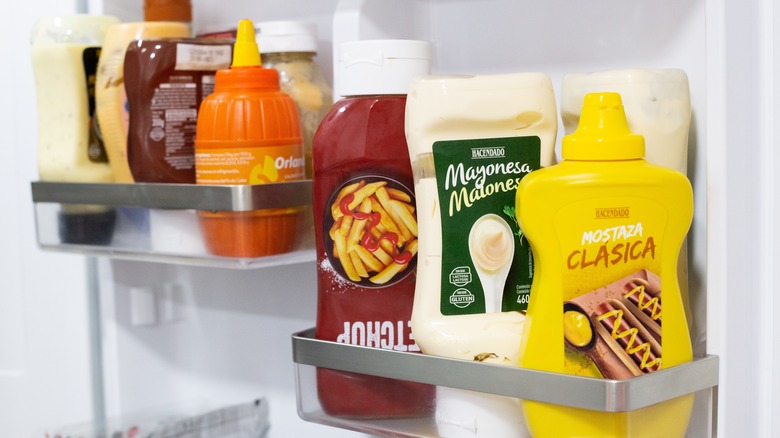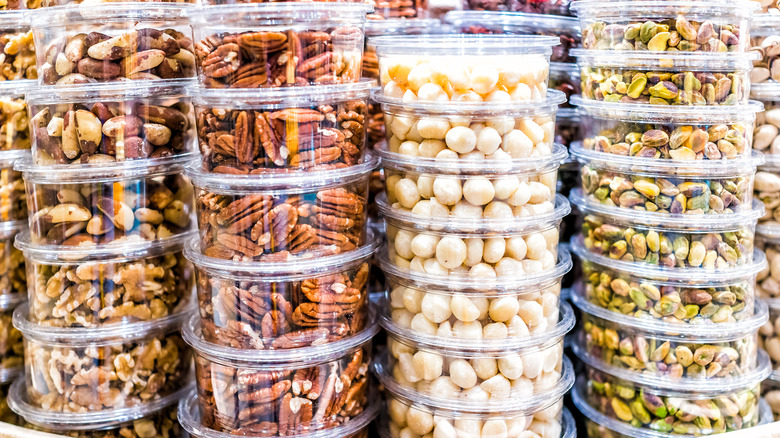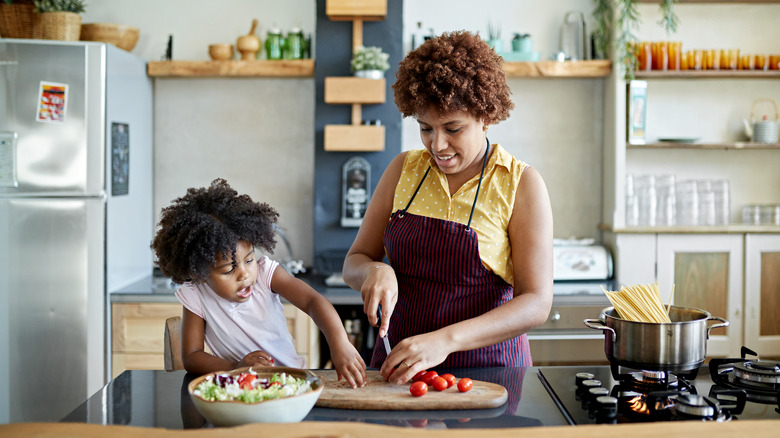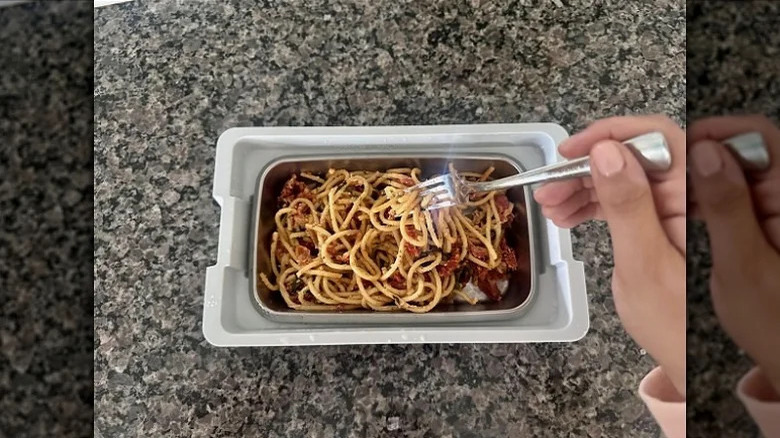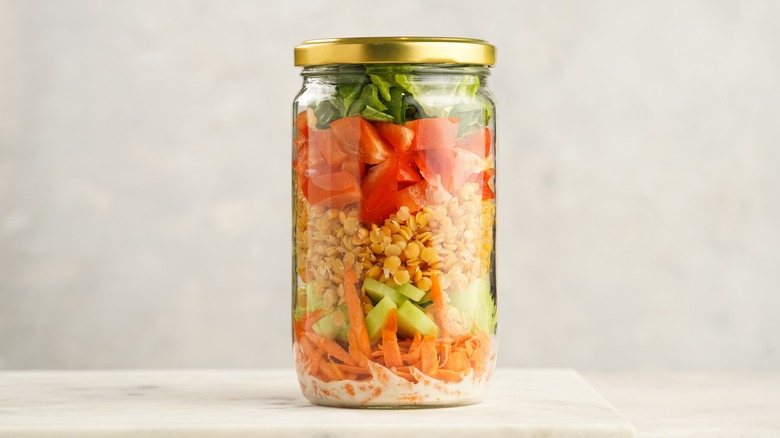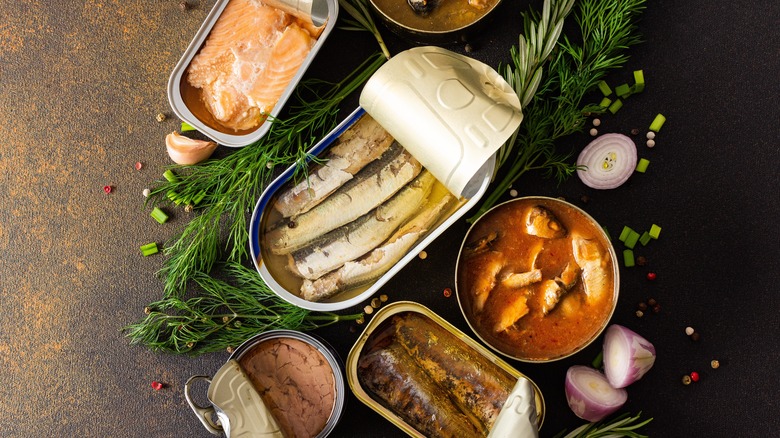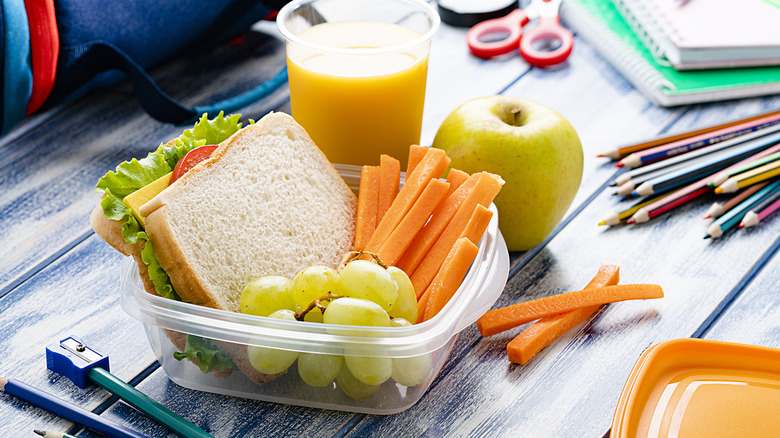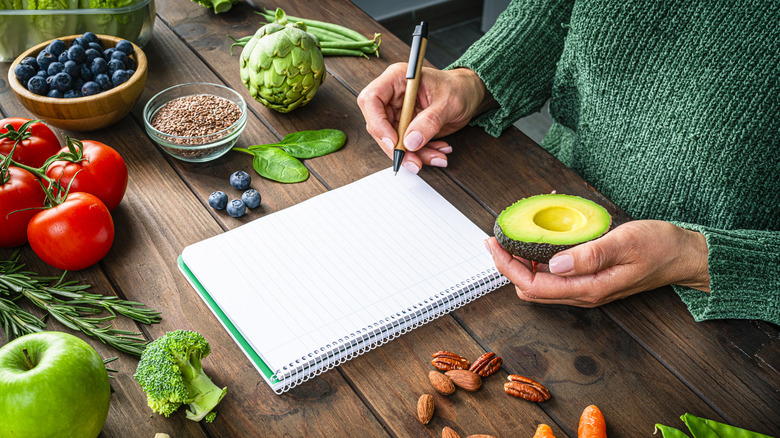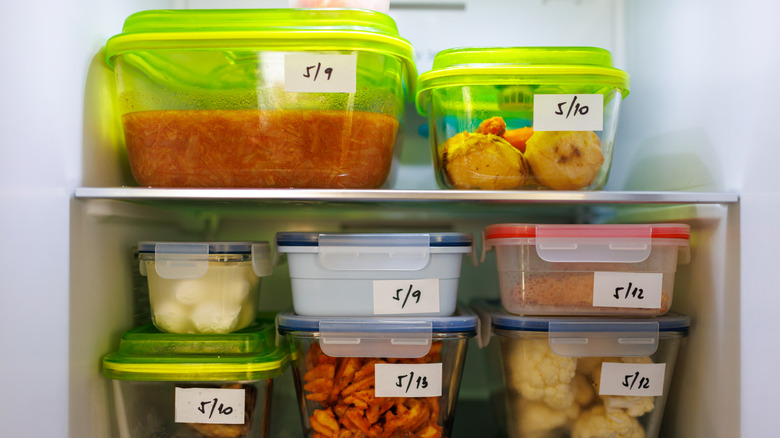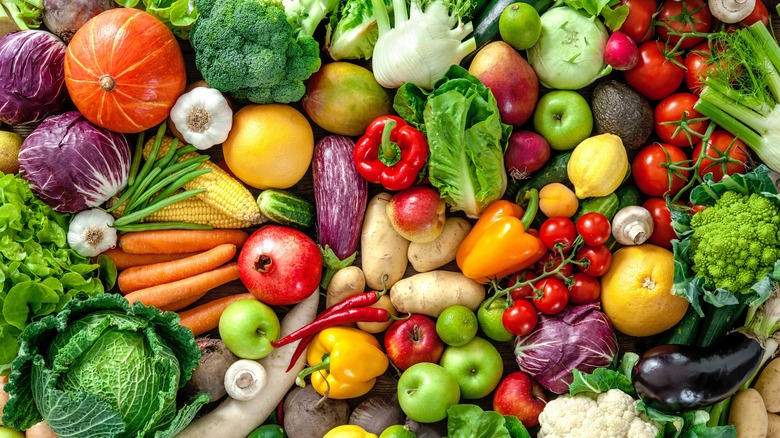14 Tips You Need To Start Using When Packing Lunch
If you don't work or attend school from home, then you know what a pain it can be to make sure you have your lunch packed every day. Sure, it may be easier to stop for a meal somewhere, but if you want to save money and eat as healthily as possible, you're better off making something at home and bringing it with you. Though that may seem like an insurmountable task at times, it's really not — as long as you follow the right tips and tricks, of course.
We've compiled a list of some of the best tips you can use when you're packing your lunch, so you can get out the door without worrying about forgetting a sandwich, a drink, or a snack. Whether you're making a meal for yourself, or trying to throw together a lunch for your little ones, these tips will ensure that packing lunch is a breeze from here on out.
Try a bento box
One of the best ways to make a meal? Use a bento box. Bento boxes hail from Japan, and they make packing a lunch super simple. These boxes have small compartments where you can keep different dishes separate, from rice and protein-based main courses to small servings of fruit or desserts. If you pick up a bento box at a store or a restaurant that sells them, you might notice the dishes are all visually appealing, too. You can get creative in your own kitchen if you want a particularly photographable lunch, or you can just keep things simple by using the compartments to keep the components of your meal separated.
Food in bento boxes is generally meant to be enjoyed cold, so don't worry about finding a way to heat everything up. Sure, bento boxes do take a bit of prep work to make at home, but once you get used to building them, you'll see just how much they can brighten up your day.
Consider meal prepping a few times a week
Meal prepping is a great way to make sure you always have something to eat for lunch, even on the busiest days of your week. But that doesn't mean you can just meal prep once a week and forget about cooking the rest of the time. According to Mayo Clinic, the cooked food in your fridge will go bad after about four days of sitting there, so you don't want to make a full week's worth of lunches on Sunday evening. Additionally, you may not know what you're going to be craving on a Friday when you make all of your lunches on Sunday.
That doesn't mean you should skip the meal prep entirely, though. It just means that you may want to prep more than once a week. Stick with the meal prep on Sunday, but make less food than you normally would for a whole week. Then, on Wednesday or Thursday, you can make a second batch of lunches that will keep you going until you're ready to cook again the next Sunday. Yes, this does mean you'll need to put in a bit more work on making lunches throughout the week, but it also ensures that you'll have the freshest, most flavorful lunches possible — we think that's worth the extra time.
Stick with tried-and-true dishes
If you're trying to expand your horizons in the kitchen, you may look forward to trying new, interesting recipes when you're packing your lunch. That may not always be the best course of action, though. After all, you never know how a new recipe is going to turn out, and the last thing you want is to make a new dish, pack it all up, and take it out to eat at work, only to realize that you don't even really like what you made. And if you cooked several batches of it? You're going to either have to suffer through a few lunches you don't actually like, or you'll end up end up just throwing it all out — not exactly ideal if you're trying to save money on lunch.
Therefore, you're usually better off sticking to tried-and-true dishes for lunch. Pack stuff you actually know you're going to eat so you won't be tempted to get takeout instead. Really want to try something new for lunch? Consider making that new recipe for dinner one night, then packing the leftovers for lunch the next day.
Remember to include seasonings and condiments
When you're prepping your lunches for the week, you're probably trying to be pretty efficient. There's a good chance you don't want to spend hours in the kitchen just thinking about what you're going to eat for the week. But you shouldn't be in such a rush that you forget to include what actually makes a dish taste good: the seasonings and condiments. Of course, when you're preparing your lunch, you'll want to use plenty of seasonings. After all, the more flavorful the meal you pack is, the less likely you'll be to end up going out for lunch instead.
It's also important to remember to pack condiments. Do you always crave mustard on your sandwiches but don't want the bread to get soggy before lunchtime? Bring a small container of mustard with you. Or maybe you need some spice to really enjoy your meal. In that case, think about bringing a bottle of hot sauce along with you. Remember, just because you're trying to be efficient with the time and money you spend on lunch, doesn't mean you shouldn't do everything you can to ensure you'll actually enjoy your lunch.
Don't forget to to pack snacks
You've already packed your sandwich, your thermos full of soup, or that rice and stir fry that you're going to reheat once you get to the office. But if that's all you have in your lunch box for the day, there's a good chance you're still going to go hungry at some point before you get home from school or work. That's why it's always a good idea to remember to pack snacks in your lunch box as well. The last thing you want to do is get so hungry that you eat the sandwich you packed for lunch well before 10:30 a.m. and then have nothing to nosh on for lunch itself.
You can prevent this kind of mishap by always having some snacks on hand. Trying to keep things healthy? Pack some cut fruits and veggies, and consider bringing some kind of dip to enjoy them with. Know you're going to crave something salty? Pack some chips or pretzels in your bag. Granola bars ─ store-bought or homemade ─ are a great snack to have on hand, as is trail mix. The more food you bring with you to work, the less chance there is of spending your money on buying overpriced food away from home.
Get your whole family involved with lunch prep
Whether you live with your immediate or extended family, a partner, or even a few roommates, it can pay to have everyone pitch in with lunch prep on a regular basis. After all, most tasks are easier to handle when you're working as a team. Making sandwiches for lunch? Instead of just making one for yourself, make a few so everyone in the house has something to bring to work or school for lunch the next day. Maybe you get the kids to pick out a snack they want to pack in their lunch boxes so they can play a role in the prep. Ask them to pick out snacks for the adults in the house as well if you want to give them a bit more responsibility.
By working together, your whole family can help make lunches on a daily basis, which cuts down on the amount of work any one person has to do. Plus, it ensures that everyone has a say in what they're going to eat for lunch the next day.
Think about using a heated lunch box
Wraps, salads, and sandwiches are typical lunch box fare, especially if you don't have anywhere to heat up a dish that needs to be served hot. But not everyone enjoys a cold lunch, especially during the colder months of the year when you just want to eat something that's going to warm you up. If you're looking for a way to enjoy a hot lunch without having to bring your own microwave into the office, you may want to consider using a heated lunch box. With these lunch boxes, you can always ensure you have a hot meal waiting for you. Some even heat up your food within minutes, negating the need for a microwave altogether.
However, heated lunch boxes can be pricey. If they're out of your price range but you don't want to give up on the idea of a hot lunch, consider buying a thermos. It's great for packing soup, pasta, rice-based dishes, and other warm meals. The thermos won't actually heat the food up for you, though, so just remember that you need to pack it warm if you want your food to be hot by the time you're ready for lunch.
Try a jarred salad
For some people, eating a packed lunch at work every day can be a bummer because it just doesn't look as appealing as the takeout your coworkers bring into the office. After all, eating your food out of plastic containers day after day doesn't always feel like a luxury experience. But you don't have to spend a ton of money to enjoy a more aesthetically pleasing lunch. Instead, just try packaging your homemade lunches in a different, more appealing way.
Mason jars are great for exactly that reason. They can be used to package your lunch in a way that actually makes you want to eat it. For example, bringing a jarred salad to work can actually make you excited to dig into a dish that may not look as good if it were packed in plastic Tupperware. Not a big fan of salads? No worries. You can also make soup in a mason jar. Just place uncooked rice noodles, tofu, and some veggies along with a cube of bouillon in a jar, then pour in some hot water when you're ready to eat. Who knew lunch could look this good?
Keep your lunch cool with a frozen drink
We've all been there before: You're packing your lunch and realize you need to put an ice pack in the box to ensure everything stays cold until you're ready to eat. But you open up the freezer and realize you don't actually have any frozen ice packs on hand. What are you supposed to do? Just pack everything at room temperature and hope it stays cold enough? That's probably not a great idea.
Instead, you may want to freeze a bottled drink and use that as an ice pack in your lunch box. You'll have to put the bottle in the freezer ahead of time, but in a few hours, it'll be ready to keep your food cool. We love this hack because it saves you some space in your lunch box, meaning you can use that room to pack even more snacks. Plus, it means you don't have to go out and buy new ice packs.
Utilize tinned fish
Some days, you have the time and energy to pack a relatively extravagant lunch for yourself. On those days, maybe you'll bring some leftover pasta, a towering sandwich stacked with all of your favorite ingredients, or perhaps some homemade sushi. Other days of the week, though, the thought of putting a slice of bologna between two pieces of bread may seem like too much work. On those days, you might want to turn to tinned fish for lunch.
Tinned fish has become ultra popular over the last several years, probably at least partially because it's so easy to prepare: Just open the tin and enjoy with chips, crackers, or whatever else you have on hand. Not only is it easy, it's also usually relatively cheap. Since you don't have to cook or prepare anything, you can easily grab some tinned fish and crackers on your way out the door, and have a simple lunch that doesn't take any time at all. If you're new to tinned fish, try starting with some canned salmon.
Pack wet sandwich toppings separately
There are few better dishes to make for lunch than a sandwich. They're easy to make, and you don't have to spend a ton of time cooking to construct a good one. They keep well in a lunch box, and most of the time, you don't even have to heat them up. However, even the best sandwich-maker can run into problems if they don't package their sandwich correctly. If you always make a beautiful sandwich in the morning only to be left with a sad, soggy sandwich at lunchtime, you may need to reevaluate how you're packing your lunch.
Sandwich toppings like meat or slices of cheese can go onto the bread a few hours before you're ready to eat lunch. But when it comes to wet sandwich toppings, like tomatoes, mayonnaise and mustard, for example, it's better to wait to add them to the sandwich. Pack them separately so they don't make the bread soggy, and then take them out and add them to the sandwich right before you're ready to eat. That way, you can ensure your sandwich tastes fresh whenever you get around to eating it.
Make a weekly lunch meal plan
Do you always wait to plan and pack your days' lunches until the morning of, when you're rushed and trying to get out the door? A lot of people do, but that may not be the best way of doing things if you want to have as stress-free a morning as possible. Instead of waiting until the day itself to think of what you're going to have for lunch, it makes more sense to make a lunch meal plan at the beginning of the week. That way, you always know what you're going to have for lunch and can plan accordingly.
Just because you're making a meal plan doesn't mean you actually have to prep everything ahead of time. Rather, it just means that you take some time out of your weekend to write down what you're going to eat for lunch in the upcoming week. That way, you'll always know what you have in the fridge and pantry, and won't end up deciding to grab takeout at the last minute.
Find ways to reuse your leftovers
Don't assume that you have to make lunch from scratch every day of the week. In fact, utilizing your leftovers may just be the best way to make sure you always have a packed lunch ready to go. You can always make a big batch of whatever you're eating for dinner and take the leftovers to work the next day. However, that doesn't mean your leftovers have to be a coherent meal to use them up. For example, you could take the leftovers of a rotisserie chicken you have on hand and repurpose them into a soup or salad. Don't be afraid to get creative here.
When you find ways to use your leftovers, you can actually negate the need to make separate lunches altogether. This can save you a ton of time and money. By making one dish and enjoying it for two meals, you can save money on groceries (since you won't have to buy so many different ingredients) and make your mornings easier than ever.
Don't pack healthy foods you don't actually like
If you're like most people, you have all the intentions to eat healthily. But when you open your lunch box and find a low-fat salad, you may be tempted to go grab some fast food instead. That's because you don't actually like the healthy food you brought with you. When you don't find your lunch appetizing, you're way more likely to go grab something else, which will probably cost more than what you packed for lunch.
Don't let all that food go to waste. Instead of packing the kind of lunch you think you should be eating, pack the stuff you know you're actually going to eat. That doesn't mean you shouldn't pack any healthy foods at all, but it does mean you should focus on healthy foods you actually know you enjoy. If you don't like salads, for example, don't try to force yourself to eat salads for lunch just because you know they're good for you. Instead, try to incorporate a bunch of veggies into another kind of dish, like a vegetable soup.
Be realistic with the kinds of lunches you bring to work or school. That way, you'll always have something to eat that you actually enjoy.

